Chapter 7: Cultivating Student Ownership with Audience, Autonomy, Discourse and Reflection
7.6 Combining the Essentials
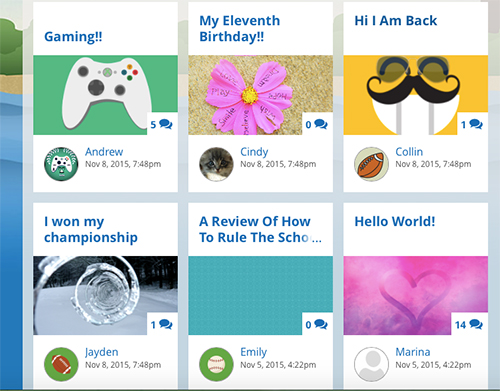
Student blogging has become such an integral part of our digital learning culture over the past few years. It’s difficult to think of a day when students aren’t blogging or thinking about blogging. While students’ blogging is trendy right now, and many are quick to hop of the blogging bandwagon, I wanted to make sure I was using blogging with purpose and intentionality. Here is an example of one student’s blogging experience that blends audience, autonomy, discourse and reflection. I believe that this example shows Gage as a digital learner who is cultivating his own learning in a powerful way.
Gage was a member of the boys’ writing club that I started a few years back. The boys voted to name it “Dudes Awesome Writing Gang”, or D.A.W.G for short. I have found, like many other teachers, that writing is a challenge for some of my male students. When asking boys why they don’t like writing, they consistently answer by saying, “It’s boring!” “I’m terrible at it.” “It hurts my hand.” “Teachers want me to write about boring stuff.” That is why I enlisted the boys in my classroom to start a optional weekly writing club. Each Friday, the boys and I would have lunch together and simply talk about our writing. Boys would share their writing and give feedback to each other. (On one occasion, one boy’s piece of writing made milk come out of another’s nose, but that is for another time.) I wanted writing to be less-threatening and engaging for the boys. No topic was off limits. I would only give a writing prompt if they were stuck. I wanted to them to see writing as a way to explain their passions, make people laugh, and share their emotions. This also proved the power of giving and getting feedback, as well as writing for an audience other than themselves.
As part of D.A.W.G., Gage was inspired by Ralph Fletcher’s Guy-Write: What Every Guy Writer Needs to Know. He wanted to use his blog to post weekly advice column for “dude writers.” Gage’s strong voice comes across in a “Tips for Dude Writers” column.
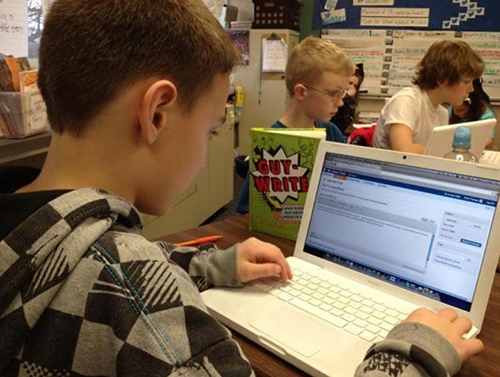
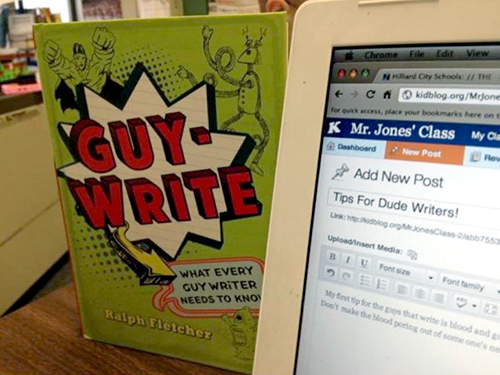
How did this simple blog post incorporate all four essential elements?
Audience
Gage’s topic was meant for an audience outside of himself. By the very nature of an advice column, he had to make sure his writing was geared towards a specific group of reader alignnone aligncenters, w in this case, is boy writers. Furthermore, after his first “Tips of Dude Writers” post, others students were demanding he write more in this series.
Autonomy
Gage was engaged with his writing piece because he had a choice of topics for his blog. He was also empowered as he wanted to share his voice to share a topic that was meaningful to him.
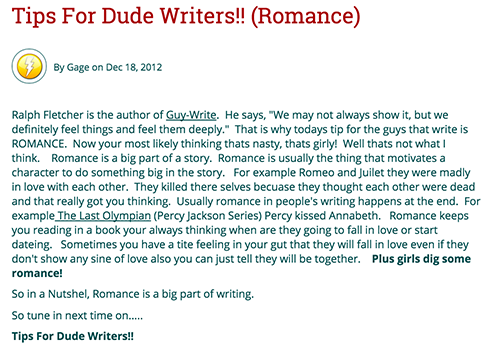
Discourse
Once posted, Gage received multiple comments about this work. As you can see, my comments focused on praising his craft. The next comment from another classmate states how he liked the examples that Gage used. Feedback is an important part of discourse as it informs the learner about how his ideas are being understood.
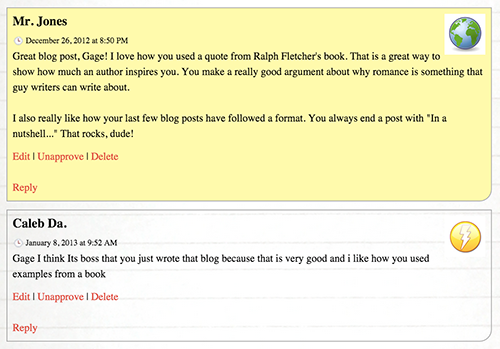
Reflection
Gage used Fletcher’s book as inspiration; in doing so, he had to reflect on Fletcher’s writing and how he could use Fletcher’s advice to get his point across.
When thinking about the digital opportunities my students are using, I want to make sure I am maximizing each opportunity for students to take control of their learning. Whether it is blogging, digital bulletin boards or other applications, I always try to ensure a digital experience that: 1) gives students more ownership of their learning than I have, and 2) helps grow their seeds of learning so they can fully harvest their digital learning farm.
Conclusion
My students have shown me that I cannot meet the demands of 21st century learning, with 20th century systems and tools. As their teacher, my hope is to continue to nurture a space where students do more purposeful digital work. Audience, autonomy, discourse and reflection have become the foundation upon which all of my students’ digital experiences are built. My hope is to design digital experiences where my students shift from merely users of digital tools to contributors of digital content. My students have been motivated to take ownership of their learning when they have:
- Had an authentic audience outside of their classroom
- A chance to reflect and give constructive feedback
- Participated in collaborative discourse with peers
- More voice and choice in the digital tools they use to show their learning.
I strive for my role to be one that encourages them as learners and empowers them to truly own their learning.